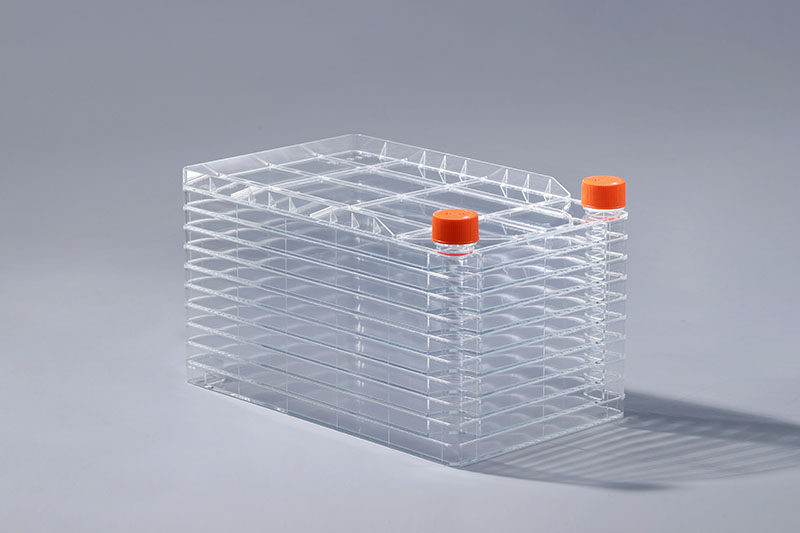เป็นวัสดุสิ้นเปลืองสำหรับการเพาะเลี้ยงเซลล์ที่ผลิตจากวัตถุดิบโพลีสไตรีน (PS) ใช้การออกแบบโครงสร้างหลายชั้น ข้อกำหนดทั่วไป ได้แก่ 1 ชั้น 2 ชั้น 5 ชั้น 10 ชั้นและ 40 ชั้น ปรับแต่งจำนวนเลเยอร์ได้ตามต้องการ ดังนั้น กระบวนการผลิตที่ใช้สำหรับโครงสร้างพิเศษของวัสดุสิ้นเปลืองนี้คืออะไร?กระบวนการฉีดขึ้นรูปที่ใช้ในโรงงานเซลล์ส่วนใหญ่ประกอบด้วยขั้นตอนต่อไปนี้:cell factory
1 ขั้นตอนก่อนการขึ้นรูป:
กระบวนการขึ้นรูปก่อนขึ้นรูปคือการที่วัสดุพลาสติกถูกให้ความร้อน ขนส่ง บีบอัด เฉือน ผสมและทำให้เป็นเนื้อเดียวกันในถังเพื่อเปลี่ยนวัสดุจากสถานะแก้วเป็นสถานะของเหลวหนืด เพื่อ ตรงตามข้อกำหนดการฉีดขึ้นรูป.
2. กระบวนการฉีดขึ้นรูป:
ในขั้นตอนการบรรจุการฉีด สกรูจะฉีดสารหลอมในห้องเก็บของเข้าไปในโพรงผ่านหัวฉีด ตัววิ่งแม่พิมพ์ และประตูที่อยู่ใต้แรงผลักดันของกระบอกฉีด
3 กระบวนการอัดและอัด:
ดำเนินการฉีดต่อเพื่อเติมปริมาตรที่ว่างโดยชิ้นส่วนเนื่องจากการหดตัว
4. กระบวนการทำความเย็นและการตั้งค่า:
หลังจากกดค้างไว้แล้ว ประตูจะถูกแช่แข็ง บทความอยู่ในช่วงการระบายความร้อนและการตั้งค่า
5. กระบวนการดีดออก:
หลังจากที่ผลิตภัณฑ์เย็นลงเป็นระยะเวลาหนึ่ง ผลิตภัณฑ์จะมีความแข็งแกร่งและความแข็งแกร่ง ชิ้นส่วนถูกขับออกจากแม่พิมพ์ฉีดโดยหมุดอีเจ็คเตอร์ของแม่พิมพ์
หลังจากการผลิตเซลล์โรงงานเสร็จสิ้นแล้ว ต้องประกอบแต่ละชั้น จากนั้นจึงจะออกจากโรงงานได้หลังจากการทดสอบต่างๆ เช่น ความรัดกุม และความเป็นหมัน เพื่อให้แน่ใจว่าเซลล์สามารถเกาะติดได้ดีขึ้น วัสดุสิ้นเปลืองนี้ยังต้องได้รับการบำบัดด้วย TC บนพื้นผิวเพื่อให้เกิดปัจจัยที่ชอบน้ำ
After the production of the cell factory is completed, each layer needs to be assembled, and then it can only leave the factory after various tests such as tightness and sterility. In order to ensure that cells can adhere better, this consumable also needs to be treated with TC on the surface to introduce hydrophilic factors.
The FAI climbed 5.9 percent year-on-year in the first 11 months of 2018, quickening from the 5.7-percent growth in Jan-Oct, the National Bureau of Statistics (NBS) said Friday in an online statement.
The key indicator of investment, dubbed a major growth driver, hit the bottom in August and has since started to rebound steadily.
In the face of emerging economic challenges home and abroad, China has stepped up efforts to stabilize investment, in particular rolling out measures to motivate private investors and channel funds into infrastructure.
Friday's data showed private investment, accounting for more than 60 percent of the total FAI, expanded by a brisk 8.7 percent.
NBS spokesperson Mao Shengyong said funds into weak economic links registered rapid increases as investment in environmental protection and agriculture jumped 42 percent and 12.5 percent respectively, much faster than the average.
In breakdown, investment in high-tech and equipment manufacturing remained vigorous with 16.1-percent and 11.6-percent increases respectively in the first 11 months. Infrastructure investment gained 3.7 percent, staying flat. Investment in property development rose 9.7 percent, also unchanged.
 English
English



















































